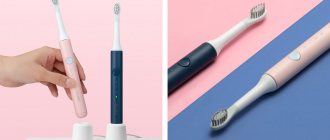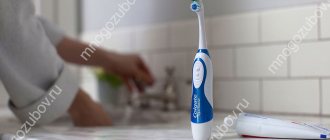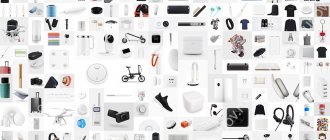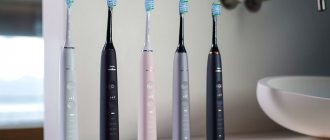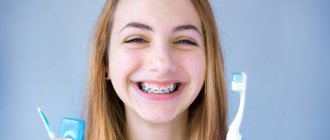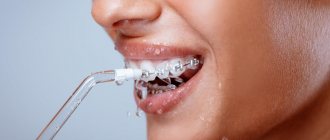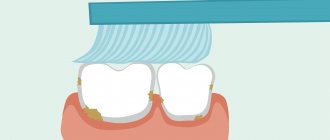To find out how effectively a patient brushes their teeth, dentists apply a compound that stains plaque. As a result, it becomes obvious that, despite regular use of a toothbrush, plaque accumulates in almost everyone and in the same places: near the gums and between the teeth. Let's figure out why this happens and how to avoid it.
As a rule, plaque forms in the same places: between the teeth and near the gums
Toothbrushes and brushing techniques
Most often, problems arise due to improper cleaning technique. If you use a regular toothbrush, hold it at a 45-degree angle to the surface of the tooth and move it away from the gum - only in this case will the plaque be removed. When moving left or right, it can become clogged in the gum, which leads to inflammation. In addition, the interdental spaces are not cleaned this way.
An electric toothbrush is easier to use - you just need to guide it along the teeth. The bristles on sonic brushes make about 30 thousand up and down movements per minute, and on ultrasonic brushes - about 100 million. This frequency allows toothpaste, water and saliva to quickly foam, washing the tooth from all sides with this flow and effectively cleaning plaque. It is impossible to achieve the same powerful cleaning with a regular toothbrush.
The bristles of electrical appliances make thousands of vibrations per minute and effectively clean plaque
In addition, electronic gadgets have different modes: gentle, intensive, whitening and others, as well as different attachments, for example, for cleaning teeth with braces or for additional polishing of enamel darkened by frequent coffee consumption.
The only negative is that dentists do not recommend using ultrasonic toothbrushes if you have braces, veneers, fillings and crowns. Their cleaning is so intense that it can lead to loss of fillings or breakage of braces. In this case, it is better to use electric brushes.
HealthQuestion to an expert: Can an irrigator replace a toothbrush?
Text: Marina Kuznetsova
We are all used to looking for answers to most of the questions that concern us In this series of materials, we ask just such questions - burning, unexpected or common - to professionals in a variety of fields.
New cosmetics and devices for skin, hair or teeth care are constantly appearing on the market - and their creators, with varying degrees of success, convince us of their necessity. Irrigator - a necessary thing or an advertising gimmick? Can it replace a toothbrush, and if not, how to combine them correctly? Who needs it, and who can do without? We asked these questions to a specialist.
Marina Kuznetsova
dentist, author of the Telegram channel Dental Jedi
Plaque is the cause not only of caries, but also of periodontal diseases. They begin with sensitivity and bleeding of the gums, that is, signs of inflammation - and can end with the destruction of the tissues surrounding the tooth root, mobility and even loss of teeth. Of course, the prevention of all this lies in hygiene - careful removal of plaque and tartar (this is the same plaque, only hardened thanks to minerals) from the surface of the tooth and from under the gums.
Only a dentist can completely remove all dental deposits, so professional hygiene must be done every six months. And at home, to maintain a good level of hygiene, you need to brush your teeth twice a day with a brush and toothpaste - and at least once a day, additionally clean the spaces between your teeth. This can be done using dental floss or an irrigator.
Until recently, dental floss was recommended by almost all dentists. Now, opinions are divided - studies indicate very low effectiveness of flossing in addition to regular teeth brushing, and even no effectiveness. As a practicing doctor, I can say that when used correctly, floss successfully removes food debris from the interdental spaces - and the key words here are “correct use.” Unfortunately, you often see how the floss cuts into the gum - it begins to bleed, while visible plaque remains in the space between the teeth. To do everything correctly, you first need to thread the floss into the interdental space, and then gradually move up towards the edge of the tooth with sawing movements, as if rubbing the thread against it. If everything is done correctly, the interdental space is cleaned and the gums are not injured.
For those who cannot master the correct technique for using floss or are too lazy to use them, I recommend paying attention to an irrigator. This is a device that consists of a reservoir for liquid and a handle with a nozzle for rinsing the interdental spaces.
The irrigator generates a stream of liquid (water or rinse aid), which removes plaque and food debris from the interdental space, while simultaneously massaging the gums. The procedure itself means that after regular brushing of your teeth with a brush and toothpaste, you take an irrigator and treat each gap in turn. This helps clean those “hard-to-reach places” and prevent the formation of denser dental deposits - tartar. Plus, the irrigator massages the gums and improves its blood circulation.
The irrigator helps clean those “hard-to-reach places” and prevent the formation of denser dental deposits - tartar
Irrigators are portable and stationary: portable ones can be taken with you on trips, to the office or to study - this is especially convenient for those who wear braces. They can be battery-powered or have a built-in rechargeable battery that needs to be charged every couple of weeks. Stationary ones are larger, often hang on the wall, and hold more liquid—that is, you don’t have to fill it in every time before brushing your teeth.
Most irrigators have several modes - pulsation, different levels of pressure - and a gradual transition from a more gentle to a stronger mode can be useful during the adaptation stage. The whole family can use one irrigator - only everyone should have their own nozzle; Usually, if additional attachments are not included in the kit, they can be purchased separately. By the way, there are different attachments, including for cleaning braces or rinsing deep periodontal pockets during periodontitis.
A study was conducted, the authors of which proved that the irrigator is really effective - it removes dental plaque from the interdental spaces and improves the condition of the gums in just 14 days. The study discussed the water pulsation mode - and this mode is available in all irrigators, even the simplest and inexpensive ones.
An irrigator is absolutely necessary for those who have crowns, bridges or braces, as well as for people with bleeding gums, a tendency to form tartar, frequent food getting stuck in the interdental spaces, and crowded (very close together) teeth. For those who have healthy and straight teeth, it will still be useful for maintaining good hygiene and preventing caries and gum disease. Of course, it does not replace a toothbrush and toothpaste, but it can replace dental floss.
Let me remind you about the general algorithm for caring for your teeth: you need to brush them twice a day with a brush and paste, once a day (for example, before going to bed) to clean the interdental spaces with an irrigator or dental floss, and visit the dentist once every six months for professional hygiene.
Photos: Elizaveta - stock.adobe.com, Dronathan Davis - stock.adobe.com
Irrigators for cleaning
An irrigator is a device that washes away plaque with water pressure and washes away food debris from the interdental crevices. It can be called a gentle alternative to dental floss.
The irrigator is indispensable when caring for teeth with braces or implants, because it carefully cleans the most inaccessible places and does not injure the tissue. The jet pressure is adjustable, and the device can also be used to hydromassage the gums to stimulate blood circulation.
In addition, you can fill the irrigator not with water, but with a composition for rinsing the mouth.
A stream of water released under pressure gently cleans teeth without injuring soft gum tissue.
Features of the devices
Irrigators and electric toothbrushes have some distinctive features that can make it more convenient for a person to make a choice if it is difficult to decide what to buy for oral care.
Irrigator
In irrigators, the types of water flow affecting the teeth may differ from each other. They are formed in various ways. The flow can be pulsed, microbubble, or in the form of a continuous jet.
Innovative – pulsating and microbubble technologies, which make it possible to quickly and effectively clean enamel and remove contaminants from dental structures. A pulsating jet hits the surface of the teeth, instantly removing particles of dirt from hard-to-reach areas, eliminating plaque.
In a microbubble flow, liquid streams combine with air bubbles, forming hydraulic microshocks under high pressure. This results in effective cleaning and simultaneous massage of the oral cavity.
Irrigators can be supplied with various attachments that help make work much more comfortable. With the help of nozzles, they not only clean the oral cavity and orthopedic products, but also clean the tongue, spray special products, and rinse the nose.
An electric toothbrush
Using an electric device, you can effectively clean your teeth, gums, tongue and inner cheeks. The device is equipped with the following elements:
- Brush head. It is removable, so the presence of several such attachments allows several people to use the device.
- The basis. A part that acts as a nozzle holder.
- With a handle. It has a built-in motor and power source.
The device operates using batteries, a rechargeable battery that requires charging. Each device must come with a charger. There are also brushes that operate exclusively on mains power.
Among other things, most modern electric brushes are equipped with additional functions:
- Display. Manufacturers often equip the device with a liquid crystal display, through which the user can count the time while brushing their teeth.
- Ultrasound indicator. It signals that it is time to finish the process of cleaning the oral cavity.
- Timer. It is designed to sound a sound signal or stop the operation of the device. The average duration of work is 2-3 minutes.
- Modes. Some electric brushes have several operating modes: for cleaning the surface of the tongue, sensitive enamel, and whitening.
- Pressure sensor. If excessive pressure is applied to the device, the gums and enamel may be damaged. Some brushes are equipped with a sensor that acts as a safety device that prevents strong pressure.
Dental floss
Nylon floss is used to clean the interdental spaces. It is pulled between the teeth, covering each one in turn so that it forms the letter “C”. Floss scrapes off plaque with more force than a waterpik. Because of this, debate continues about whether dental floss is useful: some doctors believe that it can injure soft tissues, and in cases where the gums have receded, partially exposing the root, using it can simply be painful.
When brushing, the dental floss should wrap around the tooth in a semicircle.
Most dentists agree that waterpik and dental floss are effective in different situations. The first is suitable for daily cleaning, and the second can be used when necessary and remove more durable plaque deposits.
Advantages and disadvantages
Irrigators
Irrigators have the function of a toothbrush, due to which the device has many advantages. These include the following advantages:
- Cleaning the oral cavity with an irrigator not only massages the gums and improves blood circulation, but also prevents the development of periodontal disease and gingivitis.
- Promotes effective removal of plaque without damaging the enamel.
- There is a special switch on the case, with its help the user can independently select the mode that suits him.
- The device body is made of durable plastic, which reliably protects against shock and damage when dropped.
- The device is equipped with standard and additional attachments for the care of dental structures (implants, bridges, dentures, etc.).
The disadvantages of irrigators include the fact that the nozzles cannot rotate around their axis, there is also no possibility of contactless charging, and the devices cannot be connected to a water supply.
Electric toothbrushes
Electric toothbrushes have no less advantages:
- The kit includes special attachments for cleaning the tongue - with their help it is possible to get rid of pathogenic bacteria as effectively as possible.
- Scientists have proven that using an electric brush allows you to achieve excellent results, while simultaneously removing dirt and plaque.
- The set of functions of some devices includes timers - they notify that it is time to change the cleaning of a particular area of the oral cavity.
- An electric brush perfectly removes stains from tobacco, tea, and coffee.
There are also disadvantages:
- increases the chance of caries;
- may loosen teeth;
- increases sensitivity;
- provokes separation of enamel from the gums.
Can I use an irrigator if my gums bleed?
Bleeding gums are not a contraindication. Do not forget that with the help of an irrigator, we, on the contrary, massage them and clean the oral cavity even better. People with heart disease, rosacea, acute periodontitis, as well as those who have recently installed an implant or simply undergone some kind of surgical intervention in the oral cavity should refuse to use the device (or use it with caution).
Article on the topic
Smile wider! How to get rid of bleeding gums
TOP 15: The best irrigators of 2022
Best Portable Oral Irrigators
| № | Name | Description | Price |
| 1. | Revyline RL650 | The best portable irrigator in 2022 | 52$ |
| 2. | ACleon TF200 | Compact and convenient oral irrigator | 58$ |
| 3. | Philips Sonicare AirFloss Pro/Ultra HX8424/47 | High-quality irrigator with toothbrush | 172$ |
| 4. | Revyline RL210 | Wireless self-contained irrigator for a modest price | 42$ |
| 5. | B.Well WI-911 | Impulse quality irrigator | 33$ |
The best stationary irrigators for the oral cavity
| № | Name | Description | Price |
| 1. | Revyline RL100 | The best stationary irrigator of 2022 | 42$ |
| 2. | ACleon TF600 | High-quality stationary oral irrigator | 80$ |
| 3. | Panasonic EW1611 | Ultrasonic stationary irrigator with stylish design | 160$ |
| 4. | B.Well WI-922 | A good budget stationary irrigator | 38$ |
| 5. | Revyline RL500 | Powerful Pulse Oral Irrigator | 72$ |
| 6. | Oral-B Professional Care OxyJet MD20 | Reliable stationary irrigator from a well-known brand | 50$ |
The best inexpensive irrigators (up to 1500 rubles)
| № | Name | Description | Price |
| 1. | GESS AQUA 360 | The best budget irrigator in 2022 | 9$ |
| 2. | Matwave Clean Pro V-20 | Inexpensive impulse oral irrigator | 18$ |
| 3. | Dentalpik Easy Clean | Manual inexpensive oral irrigator | 9$ |
| 4. | FFT (Favorite For Teeth) FFT-IFI-2000 | A good irrigator from the budget segment | 9$ |
Nutrition
According to the method of power supply, electric brushes are divided into three categories:
- Works from a socket . By choosing such an electric toothbrush, you can brush your teeth as much as you like, it will not turn off, and it will be powerful enough. But you can’t take it on a trip; there’s not always an outlet nearby.
- Battery powered . Not dependent on the network, you can brush your teeth anytime, anywhere. But it is not always convenient to change the battery; manufacturers often equip models with non-removable batteries. And the brush can take a long time to charge, sometimes up to 10 hours.
- Battery operated . Such models also allow you to brush your teeth where there is no outlet. Usually they are bought for business trips or travel. Batteries have an advantage over a battery - they are easier to change. Hose length . This characteristic is for conventional irrigators. Affects convenience. The hose can be 50 cm or more. If the outlet is far away, then choose an irrigator with this calculation in mind.
Is it necessary for each family member to have their own waterpik attachment?
It is advisable for everyone to have their own nozzle. Don’t forget: an irrigator is still a personal hygiene item; it comes into contact with the gums and mucous membranes. You don’t brush your teeth with the same toothbrush as a family.
Let's be honest about toothpastes. Oral care rules Read more
How difficult is the device to use?
We've looked at what an irrigator is for, now let's talk about how to use a home device for cleaning your teeth. By following the operating instructions and the recommendations presented below, you will easily master the skills of its use. Even small children can cope with this.
User manual:
- Brush your teeth and rinse your mouth.
- Pour ordinary boiled water or medical solution into a special container.
- Turn on the irrigator.
- Select the desired mode or adjust the jet pressure.
- Place the nozzle of the nozzle perpendicular to the gum.
- Treat each tooth and interdental space from all sides.
- Rinse your mouth.
- Turn off the device.
The described algorithm is only suitable for a stationary device. For a portable analogue, the sequence of actions will be slightly different.
If you still have any questions, contact a dental specialist. Our doctors will not only give recommendations for use, but also, if necessary, prescribe a medical solution that is suitable for you.
The best inexpensive irrigators (up to 1500 rubles)
In fact, the demand for irrigators has increased significantly over the past few years. Now this useful and effective device can easily be used at home. However, many still doubt the need to purchase this device. Especially for those who want to study and try an irrigator, we offer the TOP 4 best budget models, the cost of which does not exceed one and a half thousand rubles.
FFT-IFI-2000
A good irrigator from the budget segment.
FFT-IFI-2000
The rating of inexpensive irrigators opens with a model from the American brand FFT (Favorite For Teeth) - FFT-IFI-2000 (665 rubles). The key feature of this device is its low cost - you can buy it for six hundred rubles. This is a mechanical irrigator, so it does not need to be recharged, which can be considered a definite advantage. The capacity of the reservoir is, for obvious reasons, very modest - only 90 ml, which, nevertheless, will be enough for one-time use by one person. By the way, the kit includes two replaceable nozzles - one for jet cleaning of the oral cavity, and the other is intended for nasal use.
Main characteristics
- Purpose: for adults
- Irrigator power: none
- Tank capacity: 90 ml
- Jet pressure: 310 - 517 kPa
- Switch on the handle
- Dimensions (WxDxH): 37x28x25 cm
- Weight: 94 g
Video review
Advantages:
- Compact and can be used everywhere.
- Does not require power, the operating principle is mechanical.
- Suitable for nasal use as well.
- Convenience and ease of use.
Flaws:
- Weak pressure.
- Small tank volume.
- The jet of liquid released is too wide.
